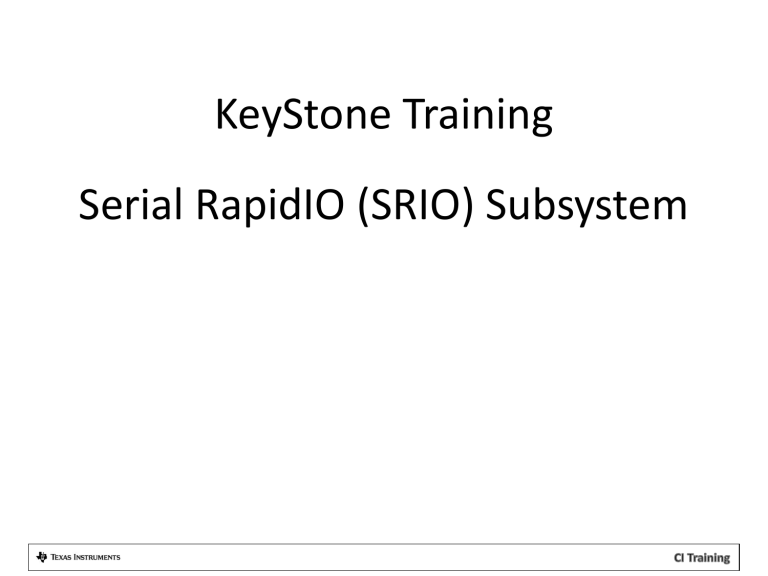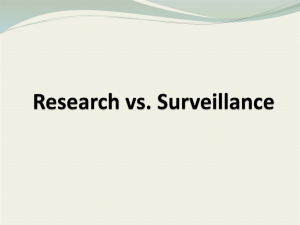KeyStone SRIO Overview
advertisement

KeyStone Training Serial RapidIO (SRIO) Subsystem Agenda • • • • • SRIO Overview DirectIO Operation Message Passing Operation Other RapidIO Features Summary SRIO Overview • • • • • SRIO Overview DirectIO Operation Message Passing Operation Other RapidIO Features Summary Introduction To RapidIO • • • Two Basic Modes of Operation: – DirectIO • Read/write operations directed to specific memory address – Transmit device has knowledge of memory map of receiving device • Functional units: – LSU (Load/Store Unit) – MAU (Memory Access Unit) – Message Passing • Mailbox and Letter designators – Transmit device does not need knowledge of memory map of receiving device • Functional units: – TXU (Message Transmit Unit) – RXU (Message Receive Unit) Data communication on differential input/output ports Overall RapidIO architecture divided into three layers: 1. Physical Layer • SERDES • RapidIO Physical layer IP 2. Transport Layer • Transports packet from physical layer to logical layer protocol units 3. Logical Layer • Protocol Units (e.g. LSUs, TXU, etc.) RapidIO 2.1.1 Compliant / RapidIO 1.2 Compliant For ports with options show in the table below: • • Data rates up to 5 Gbaud/ Data rates up to 3.125 Gbaud Different ports at different baud rates (Only integer multiple different rates are allowed) • • • • • 24 Interrupt outputs / 8 Interrupt outputs 1 MB LSU transaction size with queuing capability/ single 4 KB LSU transaction size Type 9 Packet Support (Data Streaming) External Type 9 and Type 11 queue management Strict priority scheduler / Round-robin scheduler – – • • • Round robin interleaved on a packet basis at a given priority Outbound credit-aware functional blocks 16 Local DeviceIDs & 8 Multicast IDs / 1 Local DeviceID & 3 Multicast IDs Auto-promotion of response priorities by RXU and MAU can now be disabled Ability to set the CRF (Critical Request Flow) bit on outgoing requests and responses Logical Layer • • Physical Layer New Features Compared to C64x+ SRIO in KeyStone Devices Data Interface Just for muxing PCIe with SRIO SRIO_M SRIO_M SCR_3_F CPU/3 128b VBUSM SCR M SCR_3_A CPU/3 128b VBUSM SCR M Message Passing & Type 9 Only SRIO_CPPI Wireless Applications Only M Media Applications Only KeyStone Common Configuration Interface CorePac M SCR_3P_A CPU/3 32b VBUSP SCR MPU_0 Memory Protection Unit SCR_3P_B CPU/3 32b VBUSP SCR S SRIO Packet Types New Packet Type Supported in KeyStone Physical & Logical Layer Considerations • • Tx Buffers – 16-deep shared buffer for Tx header and 16-deep shared buffer for Tx header + payload packets – If SRIO is configured for four ports in 1x mode, then 8-deep Tx physical layer buffers are supported. – If SRIO is configured for two ports in 2x mode, then 16-deep Tx physical layer buffers are supported. – If SRIO is configured for one port in 4x mode, then 32-deep Tx physical layer buffers are supported. Tx Operation – Getting outbound credit: • Based on programmed Tx watermarks • If the watermarks for a packet indicate that minimum “required buffer count” is three and if SRIO is configured for four ports in 1x mode (8deep physical layer), then after five buffers are filled, no credit is granted to that PRI of packets. • If SRIO is configured for one port in 4x mode (32-deep physical layer), then after 29 buffers are filled, no credit is granted to that PRI of packets. – Strict priority-based scheduling: • As illustrated by the example shown below, three protocol units -- LSU0, MAU, and TXU -- have packets to send. The priority of those packets are 2, 1 and 2 respectively. The scheduler will round robin between LSU0 and TXU to send data. Because LSU0 and TXU have a higher priority, the transmission of their data must be completed before the scheduler begins to send data from MAU. • Protocol units know whether they have outbound credit or not. If a protocol unit does not have outbound credit, then it will not be part of round robin scheduling. – Data reaches from shared buffer memory to physical layer memory and goes out in the same order unless there is physical layer re-ordering due to retry or any other condition. Shared Buffer for Header only Packets PBM Buffers LSUx PORT0 MAU TXU Shared Buffer for Header+Payload Packets RXU 4 Ports 1x Mode PORT1 PORT2 PORT3 Physical & Logical Layer Considerations • Rx Buffers – – – – • 16-deep shared buffer for Rx header and 16-deep shared buffer for Rx header+payload packets If SRIO is configured for four ports in 1x mode, then 8-deep physical layer Rx buffers are supported. If SRIO is configured for two ports in 2x mode, then 16-deep physical layer Rx buffers are supported. If SRIO is configured for one port in 4x mode, then 32 deep physical layer Rx buffers are supported. Rx Operation – – – Incoming data reaches to physical Layer Round Robin pickup from four ports to move to shared buffer No priorities are considered while moving from the physical layer buffers to shared buffer Shared Buffer for Header only Packets Physical Layer Buffers LSUx PORT0 MAU TXU Shared Buffer for Payload Packets PORT1 PORT2 PORT3 RXU 4 Ports 1x Mode Incoming Data Functional Diagram Shared Buffer for Header-only Packets Physical Layer Buffers PORT0 Shared Buffer for Payload Packets PORT1 PORT2 PORT3 VBUSM Master CAU 4 Ports 1x Mode Shared Buffer for Header-only Packets VBUSM Master PBM Buffers PKTDMA PORT0 LSUx MAU VBUSM Slave TXU Shared Buffer for Header+Payload Packets RXU Credit Manager PORT1 PORT2 PORT3 DirectIO Operation • • • • • SRIO Overview DirectIO Operation Message Passing Operation Other RapidIO Features Summary C66x DirectIO Operations Compared to C64x+ • 8 LSUs / 4 LSUs • Maximum transaction size (byte_count field) of 1MB / 4KB – Up to 4K packets of 256 bytes per LSU programming • Shadow Registers Concept • 128 outstanding non-posted packets in total, 16 per LSU (not configurable) • Auto-generation of doorbell at the end of transfer completion. – Send doorbell after sending last packet. OR – Send doorbell after receiving last response. – No doorbell is sent if there is an error. • Restart and flush LSU transactions. Shadow Registers Example SHADOW 1 Constant LSU0 Register Addresses for Programming LSU0_REG0 SHADOW 0 LSU0_REG0 LSU0_REG1 LSU0_REG2 LSU0_REG3 LSU0_REG4 0x02900D00 LSU0_REG0 LSU0_REG1 LSU0_REG1 LSU0_REG2 LSU0_REG3 SHADOW 2 LSU0_REG4 LSU0_REG5 LSU0_REG6 LSU0_REG2 LSU0_REG6 LSU0_REG3 LSU0_REG4 LSU0_REG5 LSU0_REG3 LSU0_REG6 LSU0_REG4 0x02900D1B LSU0_REG6 LSU0_REG1 LSU0_REG5 LSU0_REG2 LSU0_REG5 LSU0_REG0 SHADOW 8 SHADOW 7 LSU0_REG0 LSU0_REG0 LSU0_REG1 LSU0_REG1 LSU0_REG2 LSU0_REG2 LSU0_REG3 LSU0_REG3 LSU0_REG4 LSU0_REG4 LSU0_REG5 LSU0_REG5 LSU0_REG6 LSU0_REG6 Active Shadow Register Shadow Register Combinations • • Same LSU registers, so no memory map address change. Two Shadow Register groups: – – • • – – • • Shadow Group 0 for LSU0 to LSU3 Shadow Group 1 for LSU4 to LSU7 Total of 32 shadow registers with a maximum of 16 per group Shadow Register group restrictions: – • Shadow Group 0 LSU0 – LSU3 Pre-defined combinations of shadow registers per LSU. The diagram shown here identifies those combinations. Each LSU will have at least one shadow register. Maximum of nine shadow registers per LSU RIO_LSU_SETUP_REG0 register used for storing this number for each LSU. RIO_LSU_STAT_REG0 set to 2 stores completion code for each shadow register set of Shadow Group0. Same mechanism applies to Shadow Group1 for LSU3 to LSU7. Total 16 Shadow Registers LSU0 – Max 9 to Min 4 LSU1 – Max 6 to Min 3 LSU2 – Max 5 to Min 1 RIO_LSU_STAT_REG0-2 4-bits Completion Code & Context Bit For Each Shadow Register LSU3 – Max 4 to Min 1 Shadow Register Pre-defined Combinations LSU Registers 31:0 Doorbell Valid Doorbell represented by LSU_Reg1 Drbll_Info field will be sent out at the end of message. LSU_Reg0 RapidIO Destination Address MSB RapidIO Destination Address LSB/Config_Offset LSU_Reg2 LSU_Reg3 Identifies which DeviceID out of 16 Local DeviceIDs is to be used LSU_Reg4 Suppressing Interrupt for good completion and only generating for error condition DSP Source Address 31 30:20 19:0 Drbll_val RSVD Byte_Count 31:16 15:12 11:10 9:8 7:4 3:2 1 0 DestID SrcID_MAP ID_Size OutPortID Priority Xambs Sup_gint Int_Req For checking availability of LSU_Reg5 Shadow Register LSU_Reg6 (RO) LSU_Reg6 (WO) Clearing Busy Condition – In this example Core0 forgot to release the LSUx, then Core1 uses PrivID of Core0 and sets this bit. 31:16 15:8 Drbll_Info 31 30 Busy Full 7:4 3:0 FType TType 29:5 4 3:0 RSVD LCB LTID Context bit for verifying validity Hop of completion code Count LSU shadow register number 31:28 27 26:6 5:2 1 0 PrivID CBUSY RSVD SrcID_MAP Restart Flush Error response will halt the LSU. Restart will restart LSU from next shadow register. Flush discards all shadow registers with SRCID errors. Tx Operation: Non-EDMA Mode 1. LOCK LSU Read LSUx_REG6 No Shadow Register available. Poll till you get one. 2. SETUP LSUx_REG0-4 Write LSUx_REG0 Yes Full bit = 1? Write LSUx_REG1 No The LSU is already locked, Yes so it cannot be used. Busy bit = 1 · LTID field indicates which Shadow Registers will be used. Store LCB bit to verify the completion code values in future. LSUx is locked now. All other cores will see LSUx Busy bit to be 1 now. Write LSUx_REG5 LSUx Lock will be released & Busy bit will get cleared automatically Write LSUx_REG2 Write LSUx_REG3 · 3. TRIGGER TRANSFER LSU is Processing Previous Data so busy? Wait till LSU is available No Write LSUx_REG4 Yes Send Data Out Tx Operation: EDMA Mode • In this mode, the EDMA programs the shadow registers. – The LSUx_EDMA bit is available to program this mode in the SETUP register. – The EDMA programs LSU registers Reg0 to Reg5. – LSU sends the packet out and the completion generates an interrupt which triggers the EDMA once again. • The pre-requisite is that the LSU used by EDMA must not be used by any other master: – This eliminates the possibility that the LSU becomes busy by another master, so reading the busy bit is not required. – EDMA will be able to use only one shadow register so full-bit checking is also not required. – So LSU Reg6 read is not required for EDMA mode of operation. Rx Operation: MAU • – – • • • Start MAU issues four outstanding VBUSM transactions (write/read commands): Those four cannot be (same SrcID) && (same DestID) && (same or lower priority). One of these three requirements must not be matching New packet received Does the SrcID match the SrcID of a packet already in process? If packet is doorbell, then complete all outstanding transactions and post interrupt. If another doorbell comes and previous doorbell is not complete, then a RETRY is attempted on that doorbell. Packet Forwarding: – – – Incoming packet is moved to the MAU local buffer first. The packet applies for credit. If it gets the credit, then it will be moved to shared buffer. Forwarding traffic and local traffic mechanisms are separate to avoid conflicts. Pending VBUSM commands < 4? No End Yes No Does the DestID match the DestID of a packet already in process? Try Again Yes No Is the priority less than or equal to priority of packet already in process? Wait for the VBUSM command of any packet to complete Send VBUSM command for the packet No Rx Operation: MAU Example Incoming Data goes to Physical Layer Buffers in the same order. Round robin pickup from all four ports and then move to Shared Buffers. MAU transfers data to the absolute address provided in the packet segments. Shared Buffer for Header only Packets Physical Layer Buffers LSUx PORT0 MAU TXU RXU Shared Buffer for Payload Packets PORT1 PORT2 PORT3 Incoming Data Message Passing Operation • • • • • SRIO Overview DirectIO Operation Message Passing Operation Other RapidIO Features Summary C66x Message Passing Operations Compared to C64x+ • 16 Transmit & 16 Receive Channels 16 dedicated Tx queues for 16 Tx channels Queues for 16 Rx channels are assigned from this range. • 20 Receive Flows C66x Message Passing Operations Compared to C64x+ • • • • Maximum 4 KB message size Maximum of 16 segments per message 64 receive mapping table entries / 32 in 64x+ 16 outstanding multi-segment + single segment non-posted messages / 4 multisegment & 12 single-segment in 64x+ Rx Protocol-Specific Part of Descriptor • All fields are same as previous devices. No extra fields have been added here. • Message size is not part of the SRIO-specific descriptor fields, but instead is located in one of the general descriptor words. • One Rx descriptor/buffer per Type 11 message 4 CDMA pops descriptor from Free Descriptor Queue, each of which uses different size buffers. The CDMA chooses based on the message size. 3 PKTDMA channel identifies Free Descriptor Queue from the FlowID received from SRIO. BUF 0 BUF 1 BUF 2 BUF 3 FREE DESCRIPTOR QUEUE Rx Operation 2 RXU identifies Free Channel/Segmentation Context and sends data along with FlowID & Dest_QID to PKTDMA. RX CHANNEL 0 FLOW 0 1 RX CHANNEL 1 GENERAL PURPOSE DEST QUEUE FLOW 1 RX CHANNEL 2 RXU identifies SrcID, DestID, Letter & Mailbox from incoming packet and maps to FlowID and Dest_QID. GENERAL PURPOSE DEST QUEUE FLOW 18 GENERAL PURPOSE DEST QUEUE RX CHANNEL 14 FLOW 19 DESTINATION MEMORY RX CHANNEL 15 TX CHANNEL 0 TX CHANNEL 2 TRANSMIT QUEUE # 672 TX CHANNEL 14 TRANSMIT QUEUE # 674 TX CHANNEL 15 PKTDMA TRANSMIT QUEUE # 686 TRANSMIT QUEUE # 687 6 PKTDMA pushes used descriptor to Destination Queue. PKTDMA writes data to Destination Memory pointed to by Free Buffer Descriptor. RXU TXU TX CHANNEL 1 TRANSMIT QUEUE # 673 SRIO 5 Tx Protocol-Specific Part of Descriptor • All fields are same as previous devices. No extra fields have been added here. • Message size is not part of the SRIO-specific descriptor fields, but instead is located in one of the general descriptor words. • One Tx descriptor/buffer per message TX Operation Prepare Tx descriptor after 1 popping them from Free Descriptor Queue Configure the Tx channel for Tx recycle Queue and Priority BUF 0 BUF 1 BUF 2 BUF 3 FREE DESCRIPTOR QUEUE 2 Configure SRIO for linking Tx Channel/Queue with Output Port# 3 7 As soon as TXU gets credit it reads packet data from Channel & writes to Tx Shared Buffers RX CHANNEL 0 FLOW 0 RX CHANNEL 1 GENERAL PURPOSE DEST QUEUE FLOW 1 RX CHANNEL 2 GENERAL PURPOSE DEST QUEUE FLOW 18 GENERAL PURPOSE DEST QUEUE SRIO RX CHANNEL 14 FLOW 19 DESTINATION MEMORY RXU RX CHANNEL 15 TX CHANNEL 0 TXU TX CHANNEL 1 TX CHANNEL 2 TRANSMIT QUEUE # 672 TRANSMIT QUEUE # 673 TX CHANNEL 14 TRANSMIT QUEUE # 674 TX CHANNEL 15 PktDMA TRANSMIT QUEUE # 686 6 TRANSMIT QUEUE # 687 4 Push Descriptor on Respective Tx Queue 5 Respective Channel will read Descriptor & Pull data from Memory TXU Requests Protocol Specific Descriptor Info (header) & asks Credit Manager to assign Credit, if it does not have credit then TXU will try another channel’s packet TXU Scheduling • TXU scheduling requires that a TX queue be dedicated to an outbound port and priority. • For example: – – – – – – Two active channels/queues One port 4X mode, so all queues are going to the same output port. Queue 1 uses Priority 1 and has something to send. Queue 2 uses Priority 1 + CRF bit and has something to send. Queue 2 is scheduled first and starts to send packets. During the 5th packet segment transfer when the TXU is moving data to the physical layer, TX buffer Queue 3 becomes active and has Priority 2. – When Queue 2 is done moving the 5th segment to the physical layer, TXU will begin reading the header info from Queue 3 and subsequently start sending packets from Queue 3. – Only after TXU finishes all of the message from Queue 3 will it attempt to go back and send the remaining packets from Queue 2, finally followed by Queue 1 if nothing else of higher priority has shown up in the meantime. Other RapidIO Features • • • • • SRIO Overview DirectIO Operation Message Passing Operation Other RapidIO Features Summary Interrupt Destinations INTDST 0 TO INTDST 15 INTDST 16 & INTDST 20 (Doorbell Only) CorePac 0 INTDST 17 & INTDST 21 (Doorbell Only) CorePac 1 CP_INTC0 INTDST 18 & INTDST 22 (Doorbell Only) INTDST 19 & INTDST 23 (Doorbell Only) • • • 24 Interrupt Destinations (INTDST0 to INTDST23) INTDST16 to INTDST23 are only for Doorbell interrupts No Interrupt pacing on INTDST16 to INTDST23 CorePac 2 CorePac 3 TPCC 1 INTDST 0 TO INTDST 23 (i.e. ALL INTDSTx) CP_INTC1 TPCC 2 Interrupt Registers • Three sets of registers route events to INTDSTx: – ICSR (Interrupt Condition Set Register) – ICCR (Interrupt Condition Clear Register) – ICRR (Interrupt Condition Routing Register) • • • • • Doorbell has one special register -- RIO_INTERRUPT_CTL -- which has DBLL_ROUTE bit to decide whether Doorbell ICRR represents (INTDST0 to INTDST15) OR (INTDST16 to INTDST23). Doorbell events in Doorbell ICSR are same as previous devices. Error events in Error ICSR is same as previous devices. LSU events are referenced by SrcID (non-EDMA mode). As KeyStone has 16 local device ID registers, LSU events shows whether a transaction for a particular srcID is complete with Success or Error. Software controlled mapping of srcID error with a particular transaction from a particular LSU is required. LSU events with respect to PrivID (EDMA mode) SRIO LLD • • DirectIO, Type 9 and Type 11 packets support APIs With Sequence Of Operations – SRIO Peripheral Initialization – Srio_init () – SRIO Driver Instance Initialization – Srio_start () • Initialize Receive & Transmit memory regions for descriptors • Creates & Enables CDMA Channels & link them with respective queues – SRIO Socket Open – SRIO_sockOpen () • Specify Packet Type • Blocking or Non-blocking during Rx Operation – Same way SRIO_sockClose () – SRIO Socket Bind – SRIO_sockBind () • Socket Bind is applying RXU mapping entries • So max sockets are max RXU mapping entries which is 64 – Send API – SRIO_sockSend () • Triggers Tx operation with input data pointer, input data size and Destination info (e.g. Mailbox, letter) – Receive API – SRIO_sockRecv () • Triggers Rx operation with receive buffer pointer, receive socket Summary • C66x SRIO has been enhanced to deliver: – Higher performance – New transaction types – Less required CPU interaction per transaction – Better deterministic scheduling – More flexibility and system support with increased number of IDs • For more information: – Serial RapidIO (SRIO) for KeyStone Devices User Guide – Support forums at the TI E2E Community website







